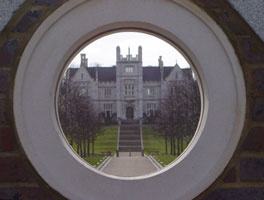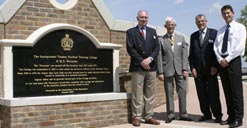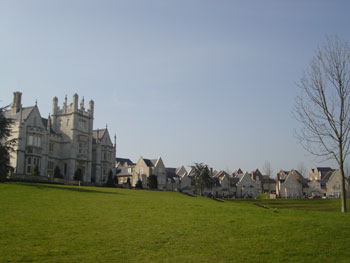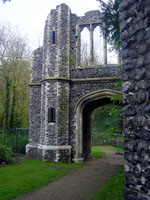|
Ingress history |
||||
|
"Here there are several wharves for the landing and shipping of corn, wood, and other commodities, but the greatest traffic arises from the chalk and lime, from the chalk pits, the range of which continues with small intermission from Stone to Gravesend, within a very short distance of the shore. Hence not only the City of London, but the adjacent counties, and even those of Suffolk and Norfolk are supplied with this commodity". The Ingress Estate was a seat in the hamlet of Greenhithe.
In 1363 the manor was endowed upon the Prioress and Abbey of the Dominican
Sisters in Dartford by Edward III (1307-1377). Legend has it that at the time of the Dissolution of the monasteries the Abbess of Dartford put a curse on Henry VIII and all his male descendants, for confiscating their property (the cash was used to finance Henry's wars). This curse was to pass to all future owners of the estate, to the effect that no male heir should ever live to inherit the estate. Henry VIII kept the site and rebuilt a country retreat for himself that he used as a stop when travelling to the coast and in 1540 made Sir Richard Long, kt., keeper of the same, with wages of 8d. a day. In 1548 the king, in consideration of the compulsory surrender of certain lands in Surrey, granted to Anne of Cleves the priory and manor of Dartford. After Henry's death, seven of the nuns who had already been permitted by Queen Mary to re-establish the conventual observance at King's Langley, with Elizabeth Cressener as prioress were permitted to return to Dartford, However in 1559 visitors from the Privy Council came to Dartford and tendered the oaths of supremacy and uni formity first to the provincial prior, and then to each of the nuns separately. All refused to take it, whereupon the visitors sold the goods of the convent at a very low rate, paid the debts of the house, divided what little remained among the sisters, and ordered them to leave within twenty-four hours. The band of Dominican exiles, consisting of two priests, the prioress, four choir-nuns, and four lay sisters, and a young girl not yet professed, joined the nuns of Syon House and crossed to the Netherlands
It was sold in 1748 to William Viscount Duncannon, who on his fathers death succeeded him as Earl of Besborough and Baron Ponsonby of Sysonby. He lived at Ingress with his wife Carolina eldest daughter of William Duke of Devonshire. He greatly improved the seat and reputedly commissioned Capability Brown to landscape the grounds (though evidence for this is lacking). In 1760 Carolina died here after losing several children and it was sold it to John Calcraft, MP for Rochester. Whilst under the ownership of William Haverlock and as a result of the was with Napoleon;s France, plans were drawn up for a large dockyard to be built from Northfleet to Greenhithe, including the Ingress estate. The manor house was demolished and then the plan dropped leaving the estate without a house. In 1820, wealthy barrister James Harman purchased the land and in 1833 built his Elizabethan mansion, Ingress Abbey, on the banks of the Thames. He provided his architect, Charles Moreing, with £120,000 for the construction of follies, grottoes and hermits caves. By the early 20th century, Harman's descendants had given up waiting for nice neighbours to move in. They sold off a large part of the grounds for development into the sprawling Empire Paper Mills. The rest of the gardens was left to go to seed and the house was allowed to fall into decay. In the middle of the last century the need for pre-sea training was recognised for potential officers in the Royal and Merchant Navy. This led a group of London shipowners to found the 'Thames Nautical Training College' in 1862. The Admiralty was approached for a ship and allocated the 'two-decker' HMS 'Worcester'. At the time, the Royal Navy was starting to replace their fleet of 'wooden walls' with iron clad vessels and they had a surplus of such vessels including the 1473 ton 50 gun 'Worcester'. She had various locations before finally moving in 1871 to what became a base forever associated with the 'Worcester' - the village of Greenhithe where successive ships remained until the 1970s. The clipper 'Cutty Sark' was given to the College in 1938, and was used as a 'boating station' moored off the Greenhithe estate coupled with thoughts of a possible shore building to house the College. However during the war years, the College was evacuated to nearby Foots Cray Place. The 'Worcester' was used as a training base by the Royal Navy and by 1945 was in a very poor condition, had lost most of her masts and only kept afloat by a large salvage pump. Happily, after the war a replacement ship was found in the form of the 'Exmouth' which became the third and last 'Worcester'. She an unusual vessel, since she was built in 1904 of steel and iron especially for nautical training and had many improvements over the converted hulks previously used. As a result of the acquisition of the fine new ship, the role of the 'Cutty Sark' diminished, and with the approval of the original donor, Mrs Dowman, she was given to the nation through the National Maritime Museum. After restoration, she was moved to a permanent dry-dock at Greenwich.
At the end of the 20th century a new life was breathed into the area and with the agreement to build new properties on the estae Crest passed the challenge for repairing the house to PJ Livesey Group. After a £6m investment a great house sits again amidst the splendour
|
Lime Kiln?
Empire Papermill
|
|||
|
|
||||
|
Links |
||||
| Comment? |
 The history of Greenhithe owes a great deal to its situation
between the River Thames and Watling Street (the London, Dover Road) and it
being a suitable landing place for ships. In Roman times known as Gretenrsce and
by 1363 Grenehuth it appears in the 1778 'History and Topographical Survey of
the County of Kent' :
The history of Greenhithe owes a great deal to its situation
between the River Thames and Watling Street (the London, Dover Road) and it
being a suitable landing place for ships. In Roman times known as Gretenrsce and
by 1363 Grenehuth it appears in the 1778 'History and Topographical Survey of
the County of Kent' :

 The College closed in 1968 and the last 'Worcester' was broken up a few years
later. The village of Greenhithe has many 'Worcester' memories such as the sign
at the waterside pub, and the streets named after 'Worcester'
personalities.
The College closed in 1968 and the last 'Worcester' was broken up a few years
later. The village of Greenhithe has many 'Worcester' memories such as the sign
at the waterside pub, and the streets named after 'Worcester'
personalities.






